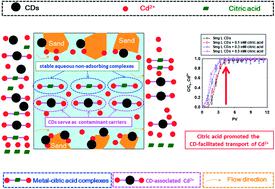当前位置:
X-MOL 学术
›
Environ. Sci.: Nano
›
论文详情
Our official English website, www.x-mol.net, welcomes your
feedback! (Note: you will need to create a separate account there.)
Insights into the effect of citric acid on the carbon dot-mediated transport of Cd2+ through saturated porous media
Environmental Science: Nano ( IF 5.8 ) Pub Date : 2022-04-14 , DOI: 10.1039/d2en00055e Haojing Zhang 1, 2 , Taotao Lu 3 , Jiuyan Chen 2 , Qiang Zhang 2 , Yanxiang Li 4 , Weifeng Chen 1 , Zhichong Qi 2
Environmental Science: Nano ( IF 5.8 ) Pub Date : 2022-04-14 , DOI: 10.1039/d2en00055e Haojing Zhang 1, 2 , Taotao Lu 3 , Jiuyan Chen 2 , Qiang Zhang 2 , Yanxiang Li 4 , Weifeng Chen 1 , Zhichong Qi 2
Affiliation

|
Carbon dots (CDs) are likely to encounter heavy metal ions (i.e., Cd2+) because of their widespread application and inevitable release into the environment, wherein the ubiquitous low-molecular-weight organic acids (LMWOAs) may affect their co-transport behaviors in aquifer systems. Herein, citric acid was used as a typical LMWOA. The effect of citric acid on the CD-mediated transport of Cd2+ through sand columns was investigated. The results demonstrated that CDs could serve as carriers to markedly enhance the transport of Cd2+, which was attributed to the abundant adsorption sites of nanoparticles for Cd2+ and the excellent mobility of CDs. Citric acid promoted the CD-facilitated transport of Cd2+ due to the formation of water-soluble metal–citric acid complexes, the facilitation of the adsorption of Cd2+ on the CDs by citric acid, and the high mobility of the CDs. Interestingly, the enhanced role of citric acid in CD-facilitated transport declined as the pH was raised from 6.0 to 8.0, since the predominant Cd2+ species (e.g., free Cd2+) in the influents preferred to deposit onto sand surfaces at a higher pH. The findings provide meaningful insights into understanding the co-transport of carbon-based nanoparticles and heavy metals affected by the presence of LMWOAs in the natural subsurface environment.
中文翻译:

柠檬酸对碳点介导的 Cd2+ 通过饱和多孔介质传输的影响
碳点(CDs)由于其广泛的应用和不可避免的释放到环境中,很可能遇到重金属离子(即Cd 2+),其中无处不在的低分子量有机酸(LMWOA)可能会影响它们的协同运输含水层系统中的行为。在此,柠檬酸被用作典型的LMWOA。研究了柠檬酸对CD 2+通过沙柱的CD 介导转运的影响。结果表明,CDs可以作为载体显着增强Cd 2+的传输,这归因于纳米粒子对Cd 2+的大量吸附位点和CDs优异的迁移率。柠檬酸促进 CD 促进的 Cd 转运2+由于水溶性金属-柠檬酸络合物的形成,柠檬酸促进 Cd 2+在 CD 上的吸附,以及 CD 的高迁移率。有趣的是,柠檬酸在 CD 促进转运中的增强作用随着 pH 从 6.0 升高到 8.0 而下降,因为流入物中的主要 Cd 2+物质(例如,游离 Cd 2+)倾向于以一定的速度沉积在沙子表面上。较高的 pH 值。这些发现为理解受自然地下环境中存在 LMWOA 影响的碳基纳米颗粒和重金属的共同运输提供了有意义的见解。
更新日期:2022-04-14
中文翻译:

柠檬酸对碳点介导的 Cd2+ 通过饱和多孔介质传输的影响
碳点(CDs)由于其广泛的应用和不可避免的释放到环境中,很可能遇到重金属离子(即Cd 2+),其中无处不在的低分子量有机酸(LMWOA)可能会影响它们的协同运输含水层系统中的行为。在此,柠檬酸被用作典型的LMWOA。研究了柠檬酸对CD 2+通过沙柱的CD 介导转运的影响。结果表明,CDs可以作为载体显着增强Cd 2+的传输,这归因于纳米粒子对Cd 2+的大量吸附位点和CDs优异的迁移率。柠檬酸促进 CD 促进的 Cd 转运2+由于水溶性金属-柠檬酸络合物的形成,柠檬酸促进 Cd 2+在 CD 上的吸附,以及 CD 的高迁移率。有趣的是,柠檬酸在 CD 促进转运中的增强作用随着 pH 从 6.0 升高到 8.0 而下降,因为流入物中的主要 Cd 2+物质(例如,游离 Cd 2+)倾向于以一定的速度沉积在沙子表面上。较高的 pH 值。这些发现为理解受自然地下环境中存在 LMWOA 影响的碳基纳米颗粒和重金属的共同运输提供了有意义的见解。






























 京公网安备 11010802027423号
京公网安备 11010802027423号